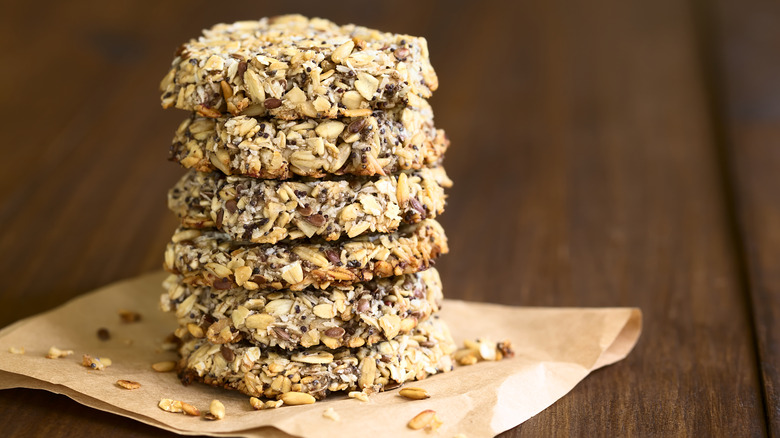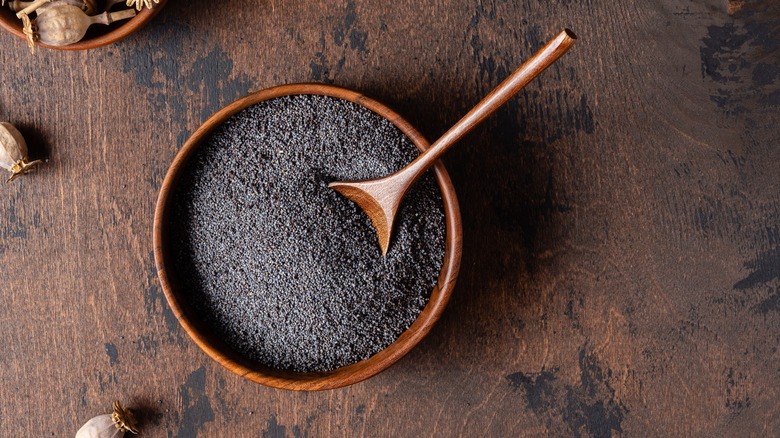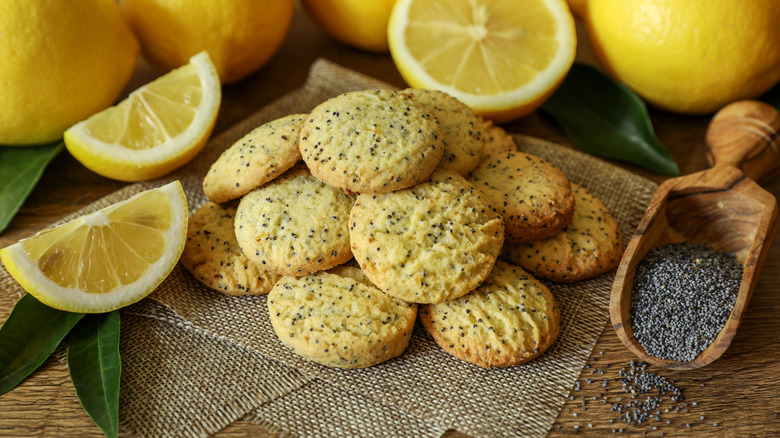Poppy Seeds Unlock A New Level Of Texture In Cookies
When it comes to cookies, there are many different consistencies that people enjoy — soft and chewy, crispy and crunchy, light and airy, and so on. In many of these cases, the texture of a cookie comes down to the amount and temperature of fat (i.e., butter) used, but in some cases, unique texture comes from a separate ingredient altogether. If you walk into a Lithuanian bakery, that ingredient might just be poppy seeds.
If you're not particularly familiar with Eastern or Northeastern European cuisines, you should know that desserts tend to be a little different from what you'll find in other parts of the world, largely due to the kind of ingredients that have historically been available in that cooler climate. Flavors tend to be light and airy rather than decadent — think vanilla and powdered sugar rather than heavy chocolate or caramel. Some desserts are made with fresh fruit, but many are made with jellies or dried fruit instead. And some ingredients that Americans might associate more with savory foods, like poppy seeds, are commonly used in sweets.
Lithuanian Christmas cookies are a prominent example of this, but not the only one; maybe you've seen Polish poppy seed babka, or poppy seed-filled hamantaschen, the classic Purim cookie. If you've never tried putting those toothsome little nutty-sweet granules in a batch of cookies before, this is your sign to start.
Don't stop, make it pop(py)
Of course, poppy seeds in sweet pastries aren't completely unheard of in the U.S. — chances are you've at least seen a poppy seed muffin or lemon poppy loaf at your favorite bakery or breakfast spot. But many of our common applications for poppy seeds are distinctly on the savory side. Everything bagels (or anything else topped with "everything" seasoning) combines poppy and sesame seeds with garlic, onion, and salt, and we also see poppy seeds topping everything from salads to hot dog buns. But given that poppy seeds have a relatively neutral flavor, it makes sense that they work in both sweet and savory dishes.
The actual flavor of poppy seeds is subtle, typically described as nutty, and often also as floral, earthy, spicy, and sweet. Arguably, they contribute more in texture than they do in taste, giving foods a sort of crunch that's pleasant and mild, not jaw-breaking. If you're bored of cookies that are just one note, texturally, poppy seeds can switch things up and add another element without making the overall cookie hard or dry. They even provide some minor health benefits, offering a small amount of your body's daily needs for calcium, phosphorus, iron, and zinc – which is exactly what you can tell anyone who gives you a funny look for eating cookies for breakfast.
In poppy-lar culture
Lithuanians have been pouring poppy seeds into their cookie dough for ages. If you visit a Lithuanian bakery or grocery store around the holidays, you're almost guaranteed to stumble upon the traditional Christmas Eve cookies. They tend to be small and crunchy (some recipes skip eggs or butter altogether) and are traditionally eaten like cereal, by the spoonful, in a bowl of poppy seed milk. Other versions of the recipe come out with softer, more standard-sized cookies, so just pick whichever sounds more appealing to you.
But poppy seed cookies don't need to be reserved for Christmas Eve by any means. Poppy seed rugelach, for example, is a classic Ashkenazi Jewish dessert eaten year-round. A quick internet search will show you all manner of contemporary recipes for lemon poppy cookies with sweet, bright icing, and more offbeat ideas like cookies that combine poppy seed with orange, cardamom, or chocolate. You can even take a page from pastry chef Claire Saffitz and try adding all sorts of seeds — poppy, but also sesame, pumpkin, flax, etc. — to any classic cookie recipe.


